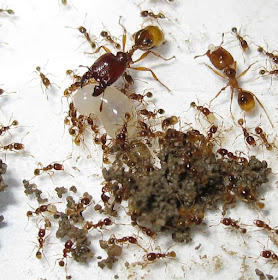This is one of the smallest Pheidologeton species. The gyne or queen measured at only 15 millimiters. The workers ranged from 2 millimeters (minor workers) to 10 millimeters (super major workers). As is typical of the smaller Pheidologeton species the workers are not as aggressive as those of Pheidologeton diversus and Pheidologeton affinis.
Pheidologeton queen and nest.
Once exposed the Pheidologeton queen is immediatedly swarmed by her workers who completely cover her.
Once exposed the Pheidologeton queen is immediatedly swarmed by her workers who completely cover her. Pheidologetons are extremely protective of their queen.
Once exposed the Pheidologeton queen is immediatedly swarmed by her workers who completely cover her. Pheidologetons are extremely protective of their queen.
The Pheidologeton queen with her three month old nest.
The nest with the first super major worker just eclosed.
Workers and brood of Pheidologeton.
A newly eclosed super major worker.
Major workers and workers of Pheidologeton ants moving brood.
Workers of Pheidologeton ants moving the pupa of a super major worker.
Workers moving a large larvae.
Taxonomy:
Top Node: cellular organismsSuperkingdom: Eukayota 2759
Opisthokonta 33154
Kingdom: Metazoa 33208 (aka Animalia)
(No Rank): Eumetazoa 6072
(No Rank): Bilateria 33213
(No Rank): Protostomia 33317
(No Rank): Ecdysozoa 1206784
(No Rank):Panarthropoda 88770
Phylum: Arthropoda 6656
(No Rank): Mandibulata 197563
(No Rank): Pancrustacea 197562
Superclass: Hexapoda 6960
Class: Insecta 50557
(No Rank): Dicondylia 85512
(No Rank): Petrygota 7496
Subclass: Neoptera 33340
Infraclass: Endopterygota 33392
Order - Hymenoptera 7399
Suborder - Apocrita 7400
Infraorder - Aculeata 7434
Superfamily - Vespoidea 34725
Family - Formicidae 36668
Subfamily - Myrmicinae 34695
Tribe: Pheidologetonini 144016
Genus - Pheidologeton 297327
Infraorder - Aculeata 7434
Superfamily - Vespoidea 34725
Family - Formicidae 36668
Subfamily - Myrmicinae 34695
Tribe: Pheidologetonini 144016
Genus - Pheidologeton 297327
Last Updated: 2012 08 28
© 2011 - 2012 Quah. All rights reserved.


























